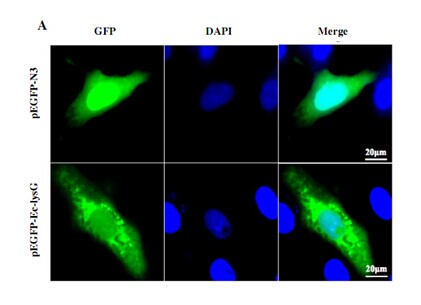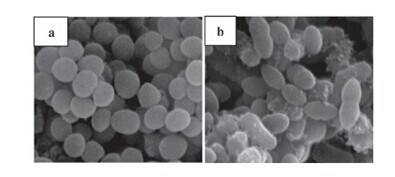Lysozymes are very important mediators of the innate immune response that can attack the peptidoglycan layer of bacterial cell walls by splitting the β-(1,4)-glycosidic bonds between the N-acetylmuramic acid (NAM) and N-acetylglucosamine (NAG), resulting in the lysis of bacteria. Apart from the antibacterial activity, lysozyme has many other functions, including antiviral, immune modulatory, anti-inflammatory and antitumor activities.
Recently, the team led by Professor QIN Qiwei from South China Sea Institute of Oceanology, CAS, has reported the molecular cloning and characterization of a new G-type lysozyme gene (Ec-lysG) in orange-spotted grouper, Epinephelus coioides. A subcellular localization analysis showed that Ec-lysG is distributed predominantly in the cytoplasm (Fig.1). The purified rEc-lysG showed lytic activities against Gram-positive bacterium Streptococcus iniae, Staphylococcus aureus, and Micrococcus lysodeikticus, and the Gram-negative bacterium V. alginolyticus. Scanning electron microscopy (SEM) showed that rEc-lysG acts on M. lysodeikticus cell walls (Fig.2). The overexpression of Ec-lysG in grouper cells did not significantly delay the occurrence of the cytopathic effect (CPE) induced by SGIV, and did not inhibit viral gene transcription. These results confirmed the importance of rEc-lysG in the antibacterial innate immunity. Further experiments are required to investigate whether the Ec-lysG affects the replication of SGIV. The study entitled “Molecular cloning and characterization of a new G-type lysozyme gene (Ec-lysG) in orange-spotted grouper, Epinephelus coioides” has been published in the Developmental and Comparative Immunology (2014, 46, 401–412).
Their previous investigations found that the purified rEc-lysC possessed the obvious antibacterial activities and the overexpression of Ec-lysC displayed the strong antiviral activities (Fish & Shellfish Immunology, 2012, 33, 186-196). The current findings may provide a new insight into the understanding of the potential action mechanisms of the two type lysozymes and host-pathogen interactions in the innate immunity of fish.
The work was performed by Dr. WEI Shina in Qin’s group and was supported by grants from National Basic Research Program of China (973) (2012CB114402), National High Technology Development Program of China (863) (2014AA093507, 2012AA092201) and Strategic Priority Research Program of the Chinese Academy of Sciences (XDA11020203).

Fig.1 Subcellular localization of grouper Ec-lysG.(Image by SCSIO)

Fig.2 Effect of rEc-lysG against Micrococcus lysodeikticus by Scanning electron micrographs. (Image by SCSIO)
